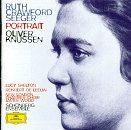The Best of 1930s Modernism
Christopher Forbes | Brooklyn,, NY | 01/27/2004
(5 out of 5 stars)
"Ruth Crawford Seeger - A PortraitThe male-dominated atmosphere of most of the arts in history has made the search for women's voices often a very difficult one, even for women earlier in this century. So many women of original achievement or promising talent were eclipsed by the men in their lives; think of Alma Mahler for instance, who had a real talent for the human voice, but sublimated it to the promotion of the music of her husband, and then to the promotion of the arts of her other husbands. Sometimes this searching for earlier women's voices leads to the promotion of composers with somewhat dubious abilities such as Amy Beach. But other times it reveals composers of freshness and distinction. Such is the case with Ruth Crawford Seeger. Her output, though small, is some of the most distinctive and original of her generation. Ruth Crawford began her career in Chicago, at the time, hardly a hotbed of musical experimentation. However, even in this out of the way location, she was able to keep abreast of the new musical experiments in Europe. Music for Small Orchestra represents her music of this time, impressionistic but non-tonal. There are echoes of Ives in the work, as well as Scriabin, and Debussy. The orchestral imagination is distinctive and both works show evidence of considerable formal innovation. The Three Chants continues in this mystical vein, but with even more evidence of development of craft. In the 1930s Crawford Seeger moved to New York and became active in the most radical wing of American composition. Influenced by iconoclastic composers like Henry Cowell, Varese, Ives, and her husband, Charles Seeger, she adopted a technique of "dissonant counterpoint". This technique, though it tends to be forgotten now in favor of concentration on European serial procedures, was integral in the music of the American radicals. Crawford Seeger's work from this period makes the best case possible for the style, which she uses with facility and ingenuity. The Three Songs for Contralto and instrumental ensemble show her new-found abilities in this style. The work is highly expressive, with a constantly changing background "ostinato"...a truly impressive work.Crawford Seeger's masterpiece in this style is her String Quartet of 1931. Tightly organized around pithy motives, this is one of the most impressive modernist works written by an American. Her freely atonal style is better developed than the styles of other similar modernists like Copland or Sessions at the time. Yet the work is also marked by logical clarity, and deeply felt emotional content. The Andante in particular is an impressive work and makes an even better string orchestra piece in its 1938 transcription. As Crawford Seeger and her husband became more and more involved in Marxist politics, their musical interests changed as well. The Adorno influenced aesthetic they had both embraced in the early 30s (modernism in music linked with leftist politics) gave way to a more populist ideal, perhaps reflecting some of the political and artistic concerns in contemporary communist Russia. In any case, both Seegers gave up composing for a long while and became interested in the folk song revival. Moving to the Washington, DC area, the couple worked with Alan and John Lomax at the Smithsonian Institution, helping to collect and arrange a treasury of American folk music. This change to folk music deeply affected the music that Crawford Seeger did write at the time. Rissolty Rossolty from 1939 is an example of a rare piece of music from this time. Written in an idiom that suggests the forms of an Ives piece, with the harmonic restraint of Copland's American period, the work is pleasant, if not as strikingly innovative as her early work.In the 1950s after taking time off to raise her children, the folk singers Peggy and Pete Seeger, Crawford returned to original composition with the intriguing Suite for Wind Quintet. This work suggests that she was on the brink of discovering a way to mix her early modernist style with her later interest in folk music. The melodies of the Suite are derived from folk music, but highly segmented and manipulated, so that all that remains of the original target tune is the mere suggestion of folkiness. Instead the work resembles a slightly more dissonant French-influenced music, rather like a spiky Poulenc. It is not a masterpiece, but it is an intriguing but ultimately sad picture of the composer. Tragically, she died soon after writing this work. The performances on this disc are by the Schonberg Ensemble led by Oliver Knussen. They are exemplary. Crawford Seeger is one American composer from this period who I think that European musicians can "get" without much effort. The vocal music is sung by Lucy Shelton, who is terrific in modernist repertoire. I don't think one could ask for a better introduction to this wonderful composer than this disc."


 Track Listings (21) - Disc #1
Track Listings (21) - Disc #1